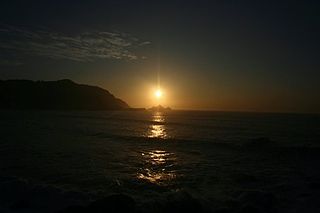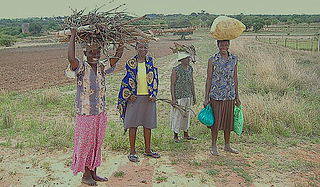Related Research Articles

Masvingo, originally Victoria, is a province in southeastern Zimbabwe. It has a population of 1.485 million as of the 2012 census, ranking fifth out of Zimbabwe's ten provinces. Established by the British South Africa Company, it was one of the five original provinces of Southern Rhodesia. In 1982, two years after Zimbabwean independence, it was renamed Masvingo Province. The province is divided into seven districts, including Masvingo District, which contains the provincial capital Masvingo City.

Matabeleland North is a province in western Zimbabwe. With a population of 749,017 as of the 2012 census, it is the country's second-least populous province, after Matabeleland South, and is the country's least densely populated province. Matabeleland North was established in 1974, when the original Matabeleland Province was divided into two provinces, the other being Matabeleland South. In 1997, the province lost territory when the city of Bulawayo became its own province. Matabeleland North is divided into seven districts. Its capital is Lupane, and Victoria Falls and Hwange are its largest towns. The name "Matabeleland" is derived from the Matabele or Ndebele people, the province's largest ethnic group.

Gonarezhou National Park is a national park located in southeastern Zimbabwe. It is situated in a relatively remote corner of Masvingo Province, south of Chimanimani along the Mozambique border. Owing to its vast size, rugged terrain and its location away from main tourist routes, large tracts of Gonarezhou remain pristine wilderness.

Buhera District is a district in Manicaland Province, Zimbabwe.

Bikita is a district in the Masvingo Province of Zimbabwe. It borders with Gutu District, Zaka District, Chipinge District, Chiredzi District, Buhera District and Mwenezi District. It is located about 80 kilometres (50 mi) east of Masvingo. Its administration is at Nyika Growth Point but initially it was at Bikita Office, 11km south of Nyika towards Jerara Growth Point in Zaka District.

Central Kalahari Game Reserve is an extensive national park in the Kalahari Desert of Botswana. Established in 1961 it covers an area of 52,800 square kilometres (20,400 sq mi), making it the second largest game reserve in the world.

Chivi, originally known as Chibi, is a district in the Masvingo Province of Zimbabwe. The area was originally established as a mission station in 1894 by the Berlin Missionary Society under the name Chibi Mission.

Mberengwa, originally known as Belingwe, is a district in Midlands province in Zimbabwe. The district is now divided into sub-districts: Mberengwa North, East, West and South. It is bounded by Gwanda in Mberengwa west, and by Zvishavane in its northern zone, to the south it stretches to Neshuro, Chikombedzi and bounded by Manyuchi dam.

Mwenezi, originally known as Nuanetsi, is a small district situated in southern Zimbabwe. It is bisected by the Mwenezi River and the A4 highway, the main thoroughfare that connects the town of Beitbridge, on the border with South Africa, to Masvingo.

Manyuchi Dam forms a reservoir on the Mwenezi River in southern Zimbabwe. It is located in the Mwenezi District. The building of the dam was financed by the Mwenezi Development Corporation. The dam was built to irrigate oil palm estates.

The Mwenezi River, originally known as the Nuanetsi River, is a major tributary of the Limpopo River. The Mwenezi River starts up in south central Zimbabwe and flows south-east along what is known as the Mwenezi River Valley that bisects the district into two sectors. The river is found in both Zimbabwe and Mozambique. In Zimbabwe it has been known as the Nuanetsi or Nuanetzi River in the past, a name it retains in Mozambique.

Maranda, locally known as "No. 1", is a small business center on the northern edge of Mwenezi (District), Zimbabwe. It is the home town of Dr. Love, the former popular musician and Nikita Mangena, Zimbabwe People's Revolutionary Army military leader during the Second Chimurenga war. It is a center of trade in the district, with people coming to sell their cattle in week-long trade fairs. The centre has a clinic and government agriculture and water offices.The land is occupied by The Vapfumbi people who speak Chipfumbi of the Kalanga and Karanga family and also partly the VhaVenda people who speak Tshivenda language.

Magomana is a small village located in Mwenezi (District). A string of mountains separates it from the main wall of Manyuchi Dam, less than five miles away in the north. The village is found on a watershed within the Maranda communal lands south of the Mwenezi River but north of the Mushawe River.

Gutu is the third largest district in Masvingo Province, southern Zimbabwe, after Chiredzi and Mwenezi. It is the northernmost district in the province. The name "Gutu" is historically reported to have emerged from "Chinomukutu wemiseve" – meaning, "the one with a load of arrows". This is according to oral historical folklore of the "Gumbo" clan who are said to have taken over the area from the "Shiri" clan through killing them by poisoning the fruit trees in the "Gona" area. Mupandawana is the largest district service centre. It was designated as a "growth point" during the early years of independent Zimbabwe together with such places as Gokwe in the Midlands Province and Juru in Mashonaland East province. Mpandawana gained town status in April 2014.

Masvingo, originally Victoria, encampases metropolitan Masvingo, in Masvingo Province in southern Zimbabwe. The district boasts of the Great Zimbabwe National Monument among its list of tourist attractions. Lake Kyle is also nearby. The people in the district are mostly rural, communal farmers. Mushandike Co-op. is found in the district, in which the villagers use the water from Tokwe River to irrigate their patches of land. Ngomahuru Hospital which is the second largest Psychiatric hospital in the country is also located.

The Mushawe River is a right-bank tributary of the Mwenezi River in Zimbabwe. It rises in the Nemande mountain area and flows through the Maranda area to join the Mwenezi River downstream of Manyuchi Dam, Mwenezi District.
Neshuro is an administrative center for Mwenezi District in Masvingo Province, south-eastern Zimbabwe. It also acts as one of the largest business centers in the drought-prone district. It is the staging front base from which aid organizations like CARE International, Oxfam launch their humanitarian actives across the district.

American Prairie is a prairie-based nature reserve in Central Montana being developed as a private project of the American Prairie Foundation (APF). This independent non-profit organization is creating a wildlife conservation area that aims to cover over 3 million acres (12,000 km2) through a combination of both private and public lands to establish a mixed grass prairie ecosystem with migration corridors and native wildlife.

The Big Sur Land Trust is a private 501(c)(3) non-profit located in Monterey, California, that has played an instrumental role in preserving land in California's Big Sur and Central Coast regions. The trust was the first to conceive of and use the "conservation buyer" method in 1989 by partnering with government and developers to offer tax benefits as an inducement to sell land at below-market rates. As of 2016, it has protected around 40,000 acres (16,187 ha) through acquisition and resale to government agencies. It has added conservation easements to another 17,000 acres (6,880 ha) and has retained ownership of a number of parcels totaling about 4,500 acres (1,821 ha).
The Sangre de Cristo Land Grant in the San Luis Valley of southern Colorado and northern New Mexico consists of 1,000,000 acres (4,000 km2) of mostly arid land. It was awarded by the government of New Mexico to the Beaubien family in 1843. The land grant was originally settled by Hispanics from New Mexico. Since the incorporation of the area of the grant into the United States in 1848, legal disputes between the descendants of the Hispanic settlers and Anglo ranchers about ownership of and access to some of the land in the grant area have been frequent and continued into the 21st century.
References
- ↑ Godhi Vhocho, doi : 10.1177/1469605305057586 Journal of Social Archaeology 2005; 5; 409 (accessed 28 February 2008)
- ↑ Willam wholmer (accessed 28 February 2008